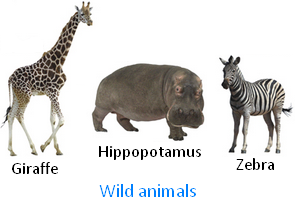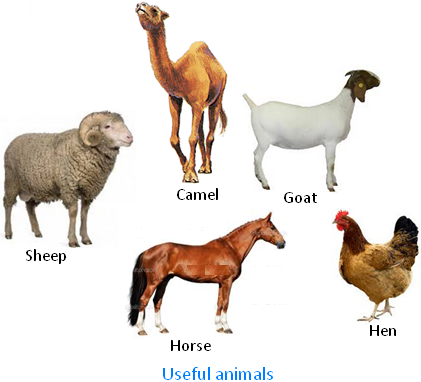Wild and Tame Animals
We will learn how to sort wild and tame animals.
Some wild animals are Giraffe, Hippopotamus, Zebra, ..... etc.
Some tame animals are Buffalo, Goat, Cow, ..... etc.
In a zoo, we see wild animals. They have been brought from all over the world. They come from many habitats—the forests, high mountains, muddy swamps, snowy, cold areas. Let us find out more about some of them.
The huge rhinoceros is a vegetarian! There are only a few of them left. They can be seen in Assam, a state of India.
Some other Indian animals are lion and tiger. These are also wild animals. They usually live in forests. Some animals are deer, peacock, tiger, lion, elephant, monkey, wild buffalo and cobra. Different wild animals are found in different countries. Some interesting animals from Africa are hippopotamus, zebra and African elephant. Animal is found both in India and Africa are elephant and zebra.
Animals can even be found in the very cold, snowy areas of the Arctic. Fish live in the seas of Arctic. Polar bears catch them for their food.
Some animals are gentle and friendly. People can keep them at home as pets. Some people keep strange pets like birds from other countries, snakes, rabbits and white mice.
Many animals are useful to us such as cow, goat and buffalo.
People often keep these animals in their homes. They feed them and look after them. These animals give us useful things.
Some of the wild and tame animals help us in more than one way, a list of ways in which these animals help us and their uses.
Camel - carries people from place to place
Buffalo - ploughs the fields
Cow - gives milk and milk products like cheese and butter
Horse - pulls carts
Goat - gives meat
Donkey - carries loads
Hen - gives eggs and meat,
Yak - gives leather for shoes, jackets, bags and belts
Sheep - gives wool and meat
From Wild and Tame Animals to HOME PAGE
Recent Articles
-
What Is Plasma? | Blood Plasma | Proteins | Nutrients | Cholesterol
Nov 07, 25 10:29 AM
Blood is a mobile fluid which is a connective tissue and is derived from the mesoderm like cell any other connective tissue. Colour of blood is reddish and that flows inside the blood vessels by means… -
Disorders of Respiratory System | Tuberculosis | Pleurisy | Emphysema
Oct 28, 25 11:39 PM
Tuberculosis is very common disease and is caused by a type of bacteria called Mycobacterium tuberculosis. This disease causes different trouble in the respiration and infection of several parts of th… -
Regulation of Respiration | Respiratory Centres | Inspiratory Area |
Oct 14, 25 12:13 AM
Respiratory Centre is the area that controls the rate of respiration and it is observed to be located in medulla oblongata and pons. Respiratory Centre has the following will dispersed components like… -
Explain Transport of Gases | External Respiration | Tissue Respiration
Oct 09, 25 11:35 PM
In humans gaseous exchange is completed in the following ways the steps are - External Respiration or Breathing - Breathing in false taking in of Oxygen and giving out of carbon dioxide in the body. M… -
Kind and Number of Teeth | Location of Teeth in Mouth | Care of Teeth
Sep 11, 25 12:52 AM
Kind and Number of Teeth









New! Comments
Have your say about what you just read! Leave me a comment in the box below.